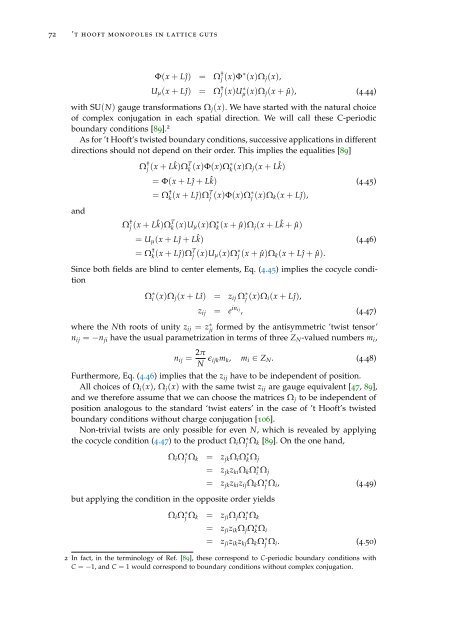Topology, symmetry, and phase transitions in lattice gauge ... - tuprints
Topology, symmetry, and phase transitions in lattice gauge ... - tuprints
Topology, symmetry, and phase transitions in lattice gauge ... - tuprints
You also want an ePaper? Increase the reach of your titles
YUMPU automatically turns print PDFs into web optimized ePapers that Google loves.
72 ’t hooft monopoles <strong>in</strong> <strong>lattice</strong> guts<br />
Φ(x + Lĵ) = Ω † j (x)Φ∗ (x)Ω j (x),<br />
U µ (x + Lĵ) = Ω † j (x)U∗ µ(x)Ω j (x + ˆµ), (4.44)<br />
with SU(N) <strong>gauge</strong> transformations Ω j (x). We have started with the natural choice<br />
of complex conjugation <strong>in</strong> each spatial direction. We will call these C-periodic<br />
boundary conditions [89]. 2<br />
As for ’t Hooft’s twisted boundary conditions, successive applications <strong>in</strong> different<br />
directions should not depend on their order. This implies the equalities [89]<br />
<strong>and</strong><br />
Ω † j (x + Lˆk)Ω T k (x)Φ(x)Ω∗ k (x)Ω j(x + Lˆk)<br />
= Φ(x + Lĵ + Lˆk)<br />
= Ω † k (x + Lĵ)ΩT j (x)Φ(x)Ω∗ j (x)Ω k(x + Lĵ),<br />
Ω † j (x + Lˆk)Ω T k (x)U µ(x)Ω ∗ k (x + ˆµ)Ω j(x + Lˆk + ˆµ)<br />
= U µ (x + Lĵ + Lˆk)<br />
= Ω † k (x + Lĵ)ΩT j (x)U µ(x)Ω ∗ j (x + ˆµ)Ω k(x + Lĵ + ˆµ).<br />
(4.45)<br />
(4.46)<br />
S<strong>in</strong>ce both fields are bl<strong>in</strong>d to center elements, Eq. (4.45) implies the cocycle condition<br />
Ω ∗ i (x)Ω j(x + Lî) = z ij Ω ∗ j (x)Ω i(x + Lĵ),<br />
z ij = e <strong>in</strong> ij<br />
, (4.47)<br />
where the Nth roots of unity z ij = z ∗ ji<br />
formed by the antisymmetric ’twist tensor’<br />
n ij = −n ji have the usual parametrization <strong>in</strong> terms of three Z N -valued numbers m i ,<br />
n ij = 2π N ɛ ijkm k , m i ∈ Z N . (4.48)<br />
Furthermore, Eq. (4.46) implies that the z ij have to be <strong>in</strong>dependent of position.<br />
All choices of Ω i (x), Ω j (x) with the same twist z ij are <strong>gauge</strong> equivalent [47, 89],<br />
<strong>and</strong> we therefore assume that we can choose the matrices Ω j to be <strong>in</strong>dependent of<br />
position analogous to the st<strong>and</strong>ard ‘twist eaters’ <strong>in</strong> the case of ’t Hooft’s twisted<br />
boundary conditions without charge conjugation [106].<br />
Non-trivial twists are only possible for even N, which is revealed by apply<strong>in</strong>g<br />
the cocycle condition (4.47) to the product Ω i Ω ∗ j Ω k [89]. On the one h<strong>and</strong>,<br />
Ω i Ω ∗ j Ω k = z jk Ω i Ω ∗ k Ω j<br />
but apply<strong>in</strong>g the condition <strong>in</strong> the opposite order yields<br />
= z jk z ki Ω k Ωi ∗ Ω j<br />
= z jk z ki z ij Ω k Ω ∗ j Ω i, (4.49)<br />
Ω i Ω ∗ j Ω k = z ji Ω j Ω ∗ i Ω k<br />
= z ji z ik Ω j Ω ∗ k Ω i<br />
= z ji z ik z kj Ω k Ω ∗ j Ω i. (4.50)<br />
2 In fact, <strong>in</strong> the term<strong>in</strong>ology of Ref. [89], these correspond to C-periodic boundary conditions with<br />
C = −1, <strong>and</strong> C = 1 would correspond to boundary conditions without complex conjugation.
















